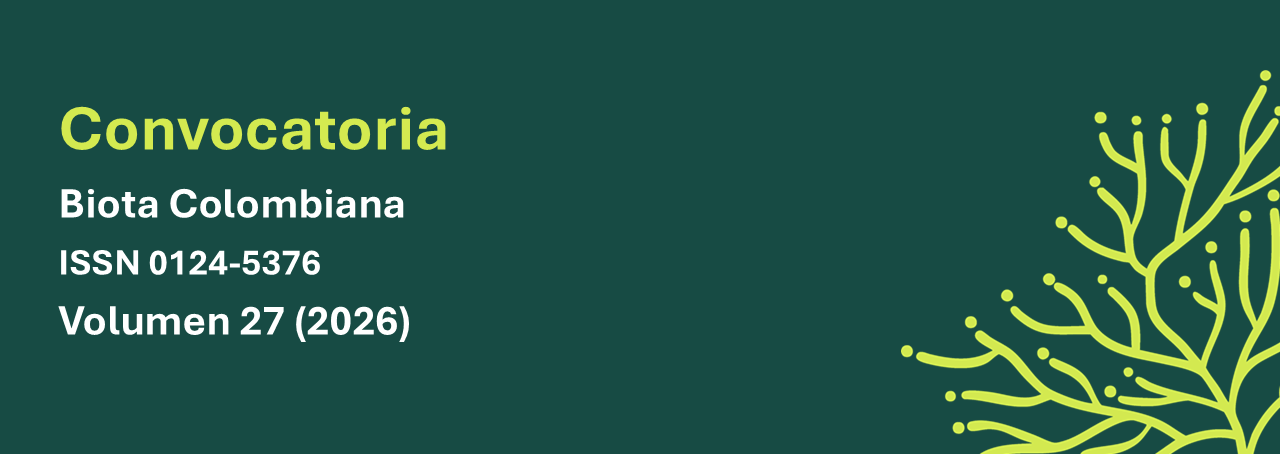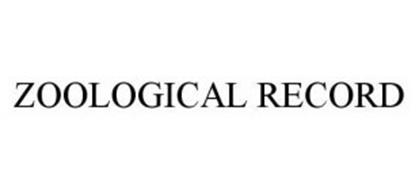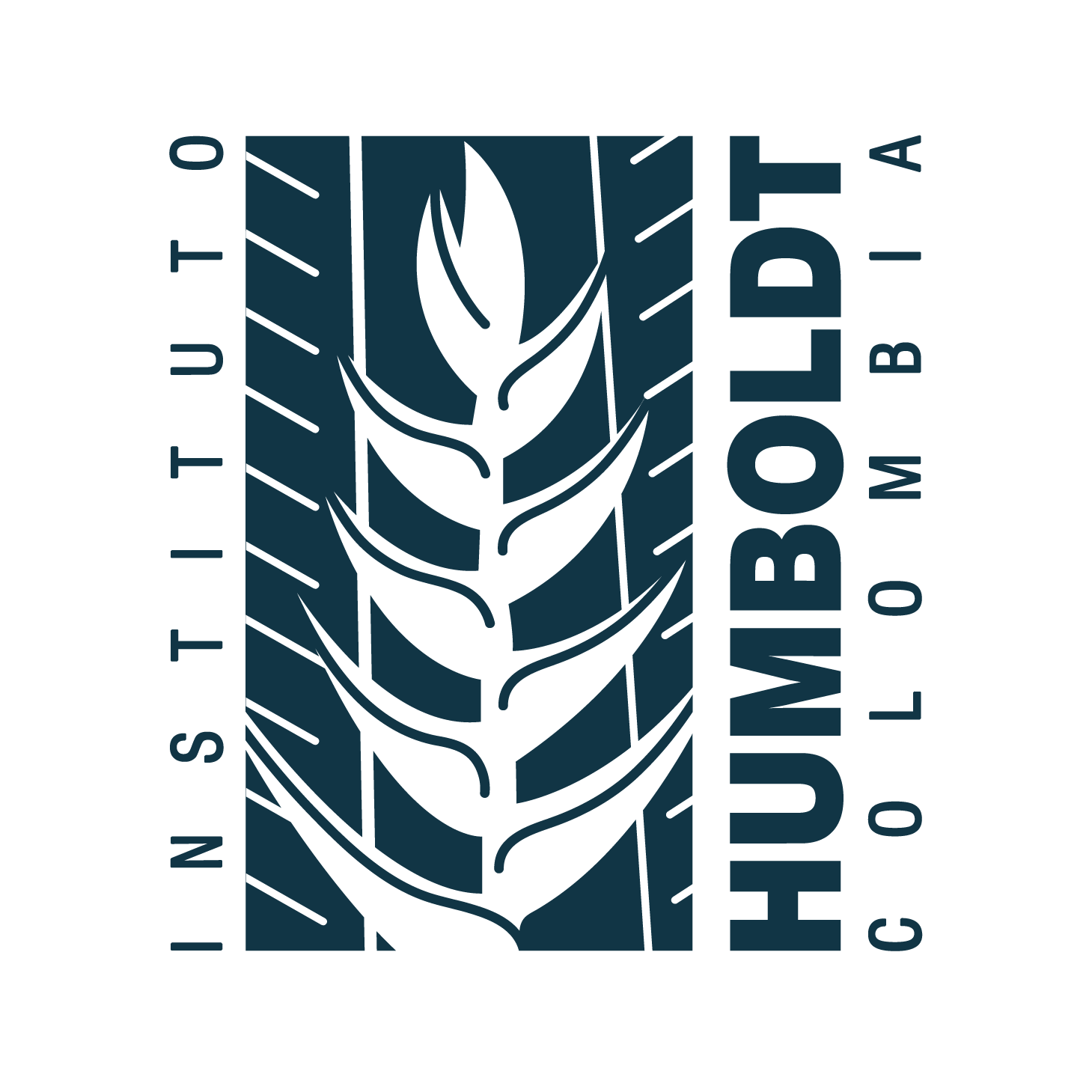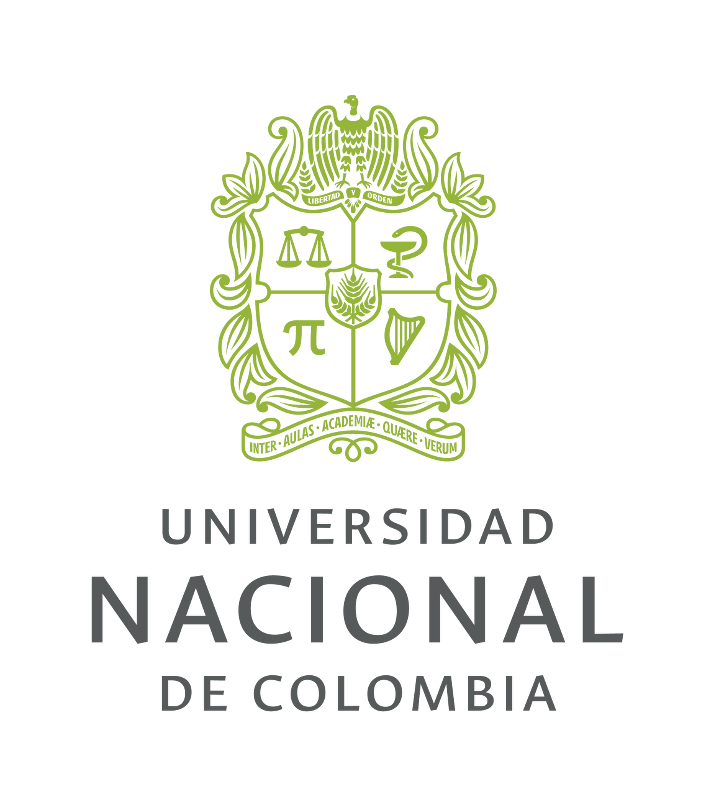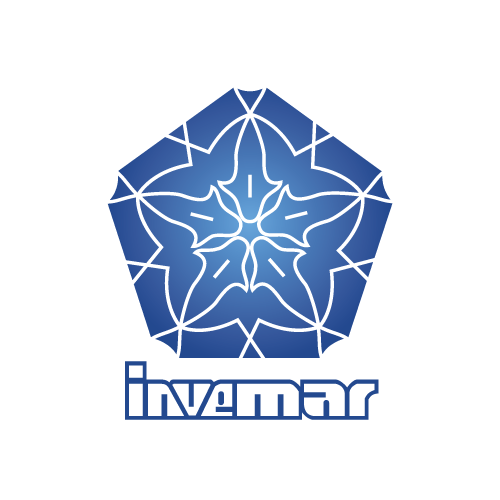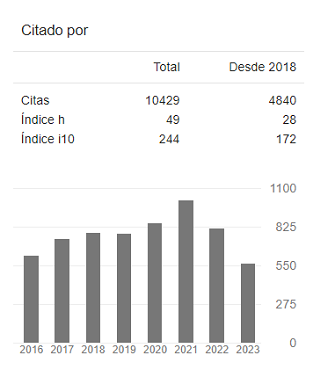Resumen (es):
La colección de anuros del Museo de La Salle es una de las más antiguas de Colombia, con 2059 especímenes recolectados desde 1917. Esa antigüedad representa un reto para cuantificar el estado de la colección de manera integral, considerando que no cumplirá necesariamente con los estándares actuales de calidad. Debido a esto, se implementó una metodología para evaluar el estado de la colección a partir de su salud, la completitud de datos, la representatividad taxonómica, la identificación taxonómica y la representatividad geográfica. Registramos 13 familias, siendo Craugastoridae la más abundante, con 44 especies y 517 especímenes. El departamento con el mayor número de especímenes es Cundinamarca, con 363 registros y 52 especies. Encontramos que la mayoría de los individuos presentan condiciones óptimas de conservación y preservación. Los resultados de esta investigación permitieron solucionar problemas de la colección, y se espera que, a partir de la metodología utilizada, el ejercicio sea de utilidad para otras colecciones.
Resumen (en):
The anuran collection of the Museo de La Salle is one of the oldest in Colombia, with 2059 specimens collected since 1917. Its age represents a challenge for a thorough quantification of its status, considering that it may not necessarily fit current quality standards. Therefore, we implemented a methodology to evaluate the status of the collection in terms of health, data completeness, taxonomic representativeness, taxonomic identification and geographical coverage. The collection harbors 13 families, with Craugastoridae as the best represented, with 44 species and 517 specimens. The department with the largest number of specimens was Cundinamarca, with 363 records of 52 species. Most specimens are in optimal condition of conservation and preservation. The results of this research enabled the solution of problems in the collection and it could be useful for other collections.
Palabras clave:
Biological collections, Curatorship, Health index, Taxonomic representativeness (en)
https://doi.org/10.21068/c2019.v20n02a08
Diagnosis of the status of the anuran collection at La Salle Museum, Bogotá, Colombia
Diagnóstico del estado de la colección de anuros del Museo de La Salle, Bogotá, Colombia
Julieth S. Cárdenas
Universidad de La Salle
Bogotá, Colombia
Diana A. Delgadillo
Universidad de los Andes
Bogotá, colombia.
Recibido: 10 de noviembre de 2018
Aceptado: 29 de julio de 2019
Abstract
The anuran collection of the Museo de La Salle is one of the oldest in Colombia, with 2059 specimens collected since 1917. Its age represents a challenge for a thorough quantification of its status, considering that it may not necessarily fit current quality standards. Therefore, we implemented a methodology to evaluate the status of the collection in terms of health, data completeness, taxonomic representativeness, taxonomic identification and geographical coverage. The collection harbors 13 families, with Craugastoridae as the best represented, with 44 species and 517 specimens. The department with the largest number of specimens was Cundinamarca, with 363 records of 52 species. Most specimens are in optimal condition of conservation and preservation. The results of this research enabled the solution of problems in the collection and it could be useful for other collections.
Keywords. Biological collections. Curatorship. Health index. Taxonomic representativeness.
Resumen
La colección de anuros del Museo de La Salle es una de las más antiguas de Colombia, con 2059 especímenes recolectados desde 1917. Esa antigüedad representa un reto para cuantificar el estado de la colección de manera integral, considerando que no cumplirá necesariamente con los estándares actuales de calidad. Debido a esto, se implementó una metodología para evaluar el estado de la colección a partir de su salud, la completitud de datos, la representatividad taxonómica, la identificación taxonómica y la representatividad geográfica. Registramos 13 familias, siendo Craugastoridae la más abundante, con 44 especies y 517 especímenes. El departamento con el mayor número de especímenes es Cundinamarca, con 363 registros y 52 especies. Encontramos que la mayoría de los individuos presentan condiciones óptimas de conservación y preservación. Los resultados de esta investigación permitieron solucionar problemas de la colección, y se espera que, a partir de la metodología utilizada, el ejercicio sea de utilidad para otras colecciones.
Palabras clave. Colecciones biológicas. Curaduría. Representatividad taxonómica. Índice de salud.
Introduction
Biological collections are representations and historical archives of a region’s or a country’s natural heritage (Ramírez & Bernal, 2006). Collections are composed of specimens and biological material such as tissues, feathers and fingerprints, among others, that are preserved, catalogued, organized (numerically, alphanumerically, phylogenetically or according to the size of the storage unit) and taxonomically determined (Lozano, 2009; SINCHI, http://www.sinchi.org.co/coleccionesbiologicas/index). Collections harbor a great diversity of specimens and information that can be used for research, exhibition or teaching (Simmons & Muñoz-Saba, 2005; Corredores, 2009). One of the purposes of a collection is to spread knowledge, popularize research and serve as a reference for studies in taxonomy, systematics, ecology, biogeography and conservation (Ramírez & Bernal, 2006; Corredores, 2009).
To contribute to these studies, biological collections must have updated and complete basic data for each specimen, such as scientific name, location, geographical coordinates, collector information, and dates, in addition to including field notes and ecological and morphological information obtained at the time of capture. However, old specimens often lack this information (Forero, 2012; Instituto Humboldt, 2014). Additionally, biological collections often have gaps in geographic information (nonexistent coordinates, department, municipality and unspecific localities), possibly due to the lack of equipment that has become more popular in recent decades as geographic positioning systems (GPS) (Lozano, 2009). These conditions limit the use of information and prevent ancient specimens from being optimally used in biogeography studies (Escalante et al., 2000; Fernández et al., 2004).
Because the quality of old collections cannot be evaluated with the same standards imposed to recent specimens, appropriate methodologies must be used to identify aspects needing corrective actions. The collection health index is one of the methodologies most frequently used to evaluate collections (Paradell & Defea, 2017). It determines, among other aspects, the status of each specimen thereby defining the collection’s general state (Simmons & Muñoz-Saba, 2005). However, it could be useful to separately consider the various aspects that account for the state of a collection, in order to determine the specific areas needing attention.
In addition to the collection health index, other parameters are used to evaluate collections, taking into account specimen data quality. Data completeness indicates how complete the information associated with the collection data matrix is. The representativeness analysis determines the representation of a taxon in the collection (at the level of genus, family or subfamily). The taxonomic identification index gives information on the level of identification of the collection. Similarly, it is possible to generate a geographical representativeness index, showing the representation of a taxon in a geographical area, either at the level of departments, municipalities or ecoregions (Corredores, 2009). All these methods have been widely used (Camacho & Burneo, 2009; Vallejo & Acosta, 2005), even for older collections that do not have available information, yet do not necessarily have poor quality.
Because of its old age, the anuran collection of Museo de La Salle, in Bogotá, Colombia, has difficulties to meet the standards currently used to evaluate biological collections. Therefore, this collection is a good candidate for implementing assessment methods that consider the above-mentioned aspects. In this study, we included some aspects of the collection health index proposed by McGinley (1993) and adopted by Simmons & Muñoz-Saba (2005), together with indicators of geographic and taxonomic data completeness, in order to determine the status of the anuran collection of the Museo de La Salle, and implement a more flexible collection evaluation methodology.
Materials and methods
Collection health index. We reviewed and evaluated 2059 anuran specimens from the amphibian collection of the Museo de La Salle. Initially we took each of the containers in which the specimens were deposited, and, using its label, confirmed the taxonomic identity through the website Amphibian Species of the World, of the American Museum of Natural History (http://research.amnh.org/vz/herpetology/amphibia/).
To calculate the collection health index, we adjusted the protocol proposed by McGinley (1993) and adopted by Simmons & Muñoz-Saba (2005). Specifically, the age of each specimen in the collection, its physical state, the quality of the information on the label, and the taxonomic identification were considered. Additionally, the possibilities of expansion, and the arrangement of the specimens in the collection were assessed. These criteria were evaluated separately in order to obtain a more detailed diagnosis of the collection’s state, and thus perform a curation process aimed at those categories that require it, unlike the method proposed by McGinley (1993) Simmons & Muñoz-Saba (2005). Considering this, the health index was divided into four categories:
Category 1 (SS): State of the specimen. This category takes into account the absence or presence of the specimen and its parts. In addition, it evaluates whether the available material allows for taxonomic determination or not; in the same way, the absence or presence of pests and the state of hydration (hydrated/dehydrated) is considered. Unlike other proposals, a value can be assigned specifically for the state of the specimen, considering the conservation conditions that specimens require for their maintenance. The criteria to evaluate this category are found in Table 1.
Table 1. Levels of curatorship for the category State of the specimen for the anuran collection of the Museo de La Salle, Bogotá, Colombia.
Category 2 (SD): Specimen data. This category assesses the presence or absence of a description, locality data (department and municipality), georeferenced localities (that have additional information (DW), such as collection date and/or collector). In this category, the age of the specimens was taken into account, in order not to discriminate specimens collected before 2000 that do not meet the currently proposed standards. The criteria for evaluating this category are found in Table 2.
Table 2. Levels of curatorship for the category “Specimen data” in the anuran collection of Museo de La Salle, Bogotá, Colombia.
Category 3 (RCTIO): Registration, cataloging, taxonomic identification and organization. This category evaluates if the specimen has some type of taxonomic determination (family, genus or species) and if it is cataloged. The criteria for evaluating this category are found in Table 3.
Table 3. Levels of curatorship for the category Registration, cataloging, taxonomic identification and organization of specimens for the anuran collection of Museo de La Salle, Bogotá, Colombia.
Category 4 (FA): Physical aspects of the collection. This category evaluates the location of the specimens, conditions and materials of storage units, and access to specimens. This category considers also problems of humidity or radiation. The criteria for evaluating this category are found in Table 4.
Table 4. Levels of curatorship for the category Physical aspects of the collection, for the collection of anurans Museo de La Salle, Bogotá, Colombia.
The first three categories were applied for each individual specimen, whereas the fourth category was applied to the whole collection, resulting in a single value for the entire collection. In order to define the state of the collection in each of the first three categories (SS, SD, RCTIO), a value was generated by category for each specimen and the three values were averaged to obtain the index for the entire collection. At the end, for the whole collection we obtained three different indexes that account for the different aspects considered by category. In each category, the index has a level of curation that goes from 0 to 10 (10 being the optimal state). The collection health index (CHI) values are ranked as high, medium or low level, based on the following criteria: 0-3.9, low; 4-6.9, medium; and 7-10, high (Cárdenas & Delgadillo, 2017).
For example, for category 1 (State of the specimen), the formulas is
where CHI(SS)=Health index of the collection with respect to the state of the specimen, SS=Values of each individual obtained by the Category 1: State of the specimen, and TS=Total of specimens in the collection.
To calculate the general collection health index [CHI(G)], the values of each category were added, and the resulting value was divided into 40, which is the maximum value that could be obtained by adding the four categories. To transform it into a percentage the value was multiplied by 100:
The Completeness of collection data was determined from the formula proposed by Vallejo & Acosta (2005) and Instituto Humboldt (2007), evaluating if each specimen had the minimum data required, according to the 87 fields stated in the Darwin Core 3.0 standard, published by SiB Colombia. For the Museo de La Salle, 39 fields are mandatory and the remaining 48 are recommended. Of the 39 mandatory fields, 12 are geographic (continent, country, country code, department, municipality, town center, locality, original location, original coordinate, original latitude and longitude and original coordinate system), 11 are taxonomic (scientific name, kingdom, phylum, class, order, family, genus, taxon category, original category of the taxon and authorship of the scientific name), and 8 are associated with the collection event, DW (registration number, identified by, number of individuals, date of the event, year, month, date and original date of the event).
The number of complete or empty mandatory fields was counted and multiplied by 100. Since not all the specimens comply with the Darwin Core standard the formula was applied separately for specimens collected before the year 2000 and those collected after 2000. For collection (DW), taxonomic (T) and geographic (G) events, the formulas followed the form
where Dc=Data completeness, Ef=Number of empty fields, and Tf=Total number of mandatory fields.
Representativeness and taxonomic identification. To determine the taxonomic representativeness of the records, we used the formula proposed by Vallejo & Acosta (2005) and Instituto Humboldt (2007):
where TRi=Taxonomic representativeness, SCi=Number of taxon species in the collection, and SCe=Number of species recorded in Colombia (http://www.batrachia.com).
The analysis of taxonomic identification was made by means of the formula proposed by the Instituto Humboldt (2007), which relates the count of records that have not been identified to species with the total of records cataloged in the collection:
where TIa=Taxonomic identification, TIid=Number of species identified in the collection, and
BRt=Total number of biological records in the collection.
Geographic representativeness. The identification of geographic representativeness was determined by means of the formula proposed by Vallejo & Acosta (2005) and Instituto Humboldt (2007), which relates the number of Colombian departments registered in the collection, with the total number of departments and multiplying it by a hundred:
where RGih=Geographic representativeness, GAih=Number of geographic areas represented in the collection, and GAh=Number of total geographic areas for Colombia.
Results
State of the specimen. We obtained a value of 9.13, which indicates that most individuals have all their parts, do not have fungi, or any type of deterioration (Figure 1A).
Specimen data. We obtained a value of 7.58, which indicates that the majority collection specimens have the fields established according to the Darwin Core standard and the criteria adopted by the Museo de La Salle. The collection has some locality data that have a relatively detailed description of the sampled area for the specimens collected before 2000. However, of these old specimens, 2088 do not comply with the field referring to geographic coordinates and 38 specimens have all the fields established in the Darwin Core standard in terms of geographical fields (Figure 1B).
Registration, cataloging, taxonomic identification and organization of the specimens. We obtained a value of 6.70, which indicates that the collection is mostly determined up to species, is cataloged and organized which allows the easy location of the specimens (Figure 1C).
Physical aspects of the collection. We found that 1998 specimens have a value of 5, with accessible storage units, but the collection does not present enough room for collection growth (Figure 1D).
The general collection health index revealed a curatorial level of 71.06 %, with the largest number of records (1633) being in level 7 (Figure 2).
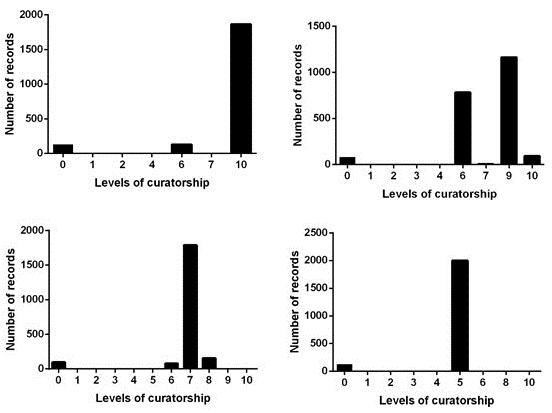
Figure 1. Health index of the anuran collection of the Museo de La Salle, Bogotá, Colombia. A. State of the specimen. B. Specimen data. C. Taxonomic determination. D. Physical aspects of the collection.
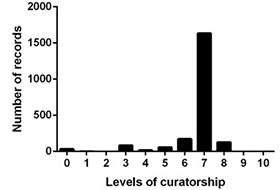
Figure 2. General health index of the anuran collection of the Museo de La Salle, Bogotá, Colombia.
Completeness of collection data. The indicator of data completeness showed that 3.22 % of the required fields for the specimens collected before the year 2000 are empty, which correspond to 1 % of the collection event (DW). Mandatory fields were missing in 879 specimens. From these data, 1.33 % correspond to taxonomic information: 1473 specimens do not have the corresponding fields, whereas 6.36 % of the specimens do not comply the Darwin Core standard (Figure 3). For the specimens collected after 2000, 2.06 % of the fields are empty, 1.96 % of the fields of the collection event (DW) are incomplete, 0.87 % corresponding to the taxonomic level, that is, 960 specimens do not comply with the standard, and 3.23 % of the geographical fields do not have the required fields (Figure 4).
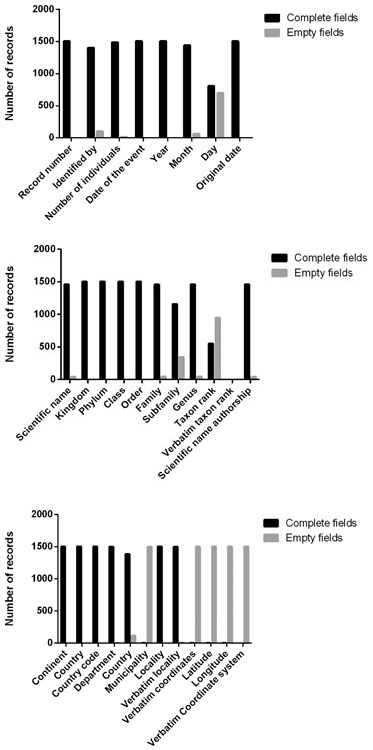
Figure 3. Data completeness of the anuran collection of the Museo de La Salle, Bogotá, Colombia, for specimens collected before 2000. A. Fields of the collection event. B. Taxonomic fields. C. Geographic fields.
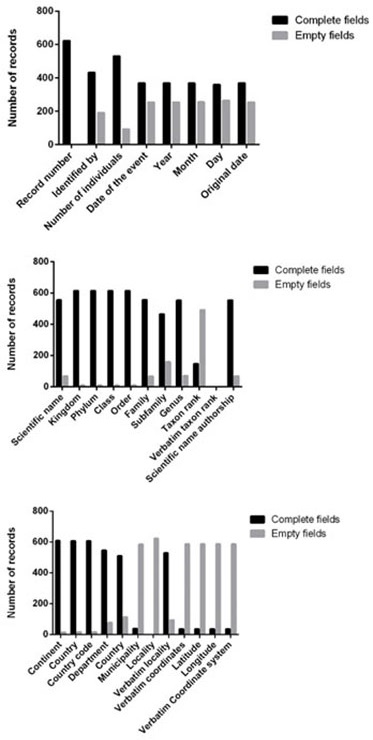
Figure 4. Data completeness of the anuran collection of the Museo de La Salle, Bogotá, Colombia, for specimens collected after 2000. A. Fields of the collection event. B. Taxonomic fields. C. Geographic fields.
Representativeness and taxonomic identification. The collection of anurans has a high representation of families (13 out of families), with Craugastoridae and Hylidae as the most representative families, with 44 species each. The family Pipidae (two species) has a low representation in the collection and the family Eleutherodactylidae is not represented. Among the most abundant subfamilies, Ceuthomantinae has 38 species, followed by Leptodactylinae, with 16 species. The least represented subfamilies are Holoadeninae and Hyalinobatrachinae, with one species each. The genus with the highest number of records and species is Pristimantis, with 489 records and 38 species, followed by Dendropsophus, with 184 records and 13 species. The genera with less species are Minyobates and Sphaenorhychus, with three records and one species each. The collection is determined up to species in 92.27 %, which corresponds to 1886 specimens. There are 60 specimens determined up to genus and 186 are not determined.
Geographical representation. At the department level, the collection has a high geographical representation, showing specimens from 31 of the 32 departments (96.87 %). The department with the highest number of records and species is Cundinamarca, with 363 records and 52 species, followed by Santander, with 260 records and 33 species. The departments with the least number of records are Vaupés, Bolívar and the Archipelago de San Andrés Providencia y Santa Catalina, with one species each (Figure 5).
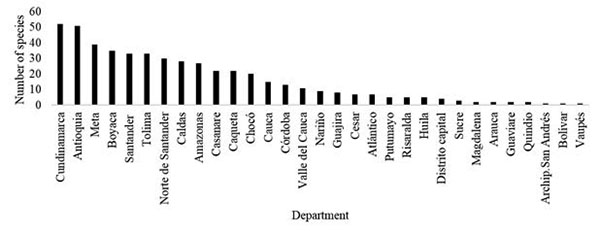
Figure 5. Geographical representativeness of the species by department in the collection of anurans of the Museo de La Salle, Bogotá.
Discussion
The main difference of our study with indexes traditionally used is that indexes were also generated by subcategories (besides a global collection health index), thus allowing for the definition of particular areas in which actions are required for the improvement of the collection (specimen state, specimen data, taxonomic determination or physical aspects of the collection). In addition, adjustments were made within the categories, to evaluate the specimens that were collected before 2005, as is the case of the presence or absence of geographic coordinates, since not all specimens have such information.
In general terms, the anuran collection of the Museo de La Salle is in good condition in comparison with those recorded for other Colombian collections. For example, the amphibian collection at the Museo de Historia Natural de la Universidad de Caldas indicates that it needs to be improved, since it had incomplete curatorship and digitization (Serna-Botero & Ramírez- Castaño, 2017) its important to clarify that this data is the result of another methodology, which means that a direct comparison cannot be made between the two studies. At the Instituto Humboldt, 4701 specimens of the amphibian collection (52.39 %) are in level 5, showing that the collection needs re-labeling, taxonomic updating and organization (Rueda, 2005). The herpetological collection of the Pontificia Universidad Javeriana had a health index of 1.46 %, which indicates that it needs improvement; the low value is due to the lack of information records for specimens, and geographic information in field notebooks, in addition to an inadequate organization of the collection (Corredores, 2009).
In 2009, the Museo de La Salle evaluated the health index of its anuran collection (strictly following the methods proposed by Simmons & Muñoz-Saba (2005). In that study, the general health index obtained was 1.21 % (Contreras, 2009), evidencing a low level of curatorship, the lack of cataloging, the need to improve storage conditions, verification and updating of taxonomic determinations, standardization of localities and georeferencing, as well as reviewing if the specimens were reported in scientific publications.
The current health index of the La Salle collection shows that its curatorship has improved. In 2009 the collection was arranged taxonomically, and today it is completely based on a catalog number system and numerically arranged. In the new method proposed here, specific aspects of the specimens were considered and not only general aspects that could cause a conflict when deciding the assignment of a curatorial level (Appendix 1). When analyzing each category separately, it is possible to see that not all categories are at the same level, which allows proposing management strategies and determining improvements for each category.
A method similar to the one proposed in this paper was proposed by the Museo de Zoología de la Pontificia Universidad Católica del Ecuador (QCAZ). The authors describe by subcategories the criteria to evaluate the status of the specimens (Camacho & Burneo, 2009), obtaining a value roughly similar to that of Museo de La Salle (79 %).
The figure of 3.22 % of fields empty for the specimens collected before 2000 reflects the fact that the collection has old specimens which do not fulfill the Darwin Core standard. This emphasizes the need of a special analysis for specimens older than 10 years. Even if they do not meet modern standards, those specimens are of vital importance, because they can be used for genetic studies involving species and populations already extinct (Burrell et al., 2015). These collections also offer the opportunity to do future research in taxonomy and evolutionary history of species located in remote areas, using modern techniques (Besnard et al., 2016).
In the specimens with records, the figure of 2.06 % of specimens obtained after the year 2000, which do not comply with the Darwin Core standard is low compared to that found by Corredores (2009), in which a value of 92.7 % empty mandatory fields was obtained. On the other hand, in the collection of Museo de Historia Natural de la Universidad de Caldas, 50 % of the fields corresponding to microhabitat and description were empty (Serna-Botero & Ramírez- Castaño, 2017). Additionally, the collection of Museo Javeriano (MUJ) presented a percentage of 76.6 % with critical fields, due to the methods used to enter the information into the databases (Vallejo & Acosta, 2005). These fields prevent the information contained in the databases from being used efficiently, thus limiting their scope (Villarreal et al., 2006; Trujillo et al., 2014).
The collection of the Museo de La Salle has 8.82 % of specimens without information in geographical fields, limiting the utility of the collection. However, many of these specimens have the description of locality, allowing for a future georeferencing process (Besnard et al., 2016). The results of this research show the enormous possibility of using the collection of anurans at the Museo de La Salle in different studies.
The anuran collection has 1607 specimens that comply with all the obligatory taxonomic fields. Their information can strengthen the national biodiversity inventory (MADS, 2013). The lack of geographic data, specifically in terms of georeferences for Museo de La Salle and the data obtained for the Museo de Historia Natural de La Universidad de Caldas, in which of the information was complete (data collector, locations, georeferencing, among others). That collection, unlike the one of the Museo de La Salle, has morphometric information. However, in both institutions the microhabitat information, field descriptions and additional observations are not present in the database or in the specimen (Serna-Botero & Ramírez-Castaño, 2017). However, those specimens and their information may be useful data sources about the country's biodiversity (Donato et al., 2015www.sibcolombia.net).
Because of its high geographical representativeness (96.87 %) the anuran collection of Museo de La Salle plays an important role as an information repository for the country (Besnard et al., 2016). In addition, this information allows for the identification of sites where species can potentially be found and areas with high specific richness (Flores-Maldonado et al., 2015).
The indices used in this study may generate a diagnosis in which all the necessary aspects for the conservation of biological collections are considered, and thus monitoring, maintenance and improvement strategies may be developed. In this way, the role of collections as sources of information for different types of research about taxonomy, biological diversity, geographic distribution or genetics, among others, may be enhanced.
Reference
Acosta, G. (2017). Lista de los anfibios de Colombia. Online reference. Obtained on March 5th, 2017 from
Besnard, G., Bertrand. J., Delahaie, B., Bourgeios, Y., Lhuillier, E. & Thébaud, C. (2016). Valuing museum specimens: high-throughput DNA sequencing on historical collections of New Guinea crowned pigeons (Goura). Biological Journal of the Linnean Society, 117(1), 71-82.
https://doi.org/10.1111/bij.12494
Berrío, J., Vásquez, M. & Estrada, V. (2011). Museo de Historia Natural Colegio de San José Natural and historical heritage. Colección Bicentenario de Antioquia. 72 pp
Burrell, A., Disotell, T. & Bergey, C. (2015). The use of museum specimens with high-throughput DNA sequencers. Journal of Human Evolution, 79, 35-44.
https://doi.org/10.1016/j.jhevol.2014.10.015
Cárdenas, S. & Delgadillo, A. (2017). Diagnostico del estado de la colección de anuros del Museo de La Salle - Bogotá. (Thesis). Bogotá D. C.: Universidad de La Salle. 57 pp.
Camacho, A. & Burneo, S. (2009). Assessment of the mammal collection at the Museo de Zoología of the Pontificia Universidad Católica del Ecuador – QCAZ. Museology, 12, 1-11.
Contreras, N. (2009). Colecciones: Batracologia: Anuros (Ranas y Sapos). (Technical report). Bogotá, D. C.: Museo de La Salle Bogotá. 9 pp.
Corredores, L. (2009). Diagnóstico de la colección de referencia de anfibios de la Pontificia Universidad Javeriana. (Degree work). Bogotá D. C.: Pontificia Universidad Javeriana, Faculty of Sciences, Department of Biology. 125 pp.
Donato, J., Ortiz, C., Vega, E., Ramírez, A. & Vieira, P. (2015). Plan institucional cuatrienal de investigación ambiental 2015-2018. Bogotá, D. C.: Instituto de Investigación de Recursos Biológicos Alexander von Humboldt. 88 pp.
Escalante, T., Llorente, J., Espinosa, D. & Soberón, J. (2000). Base de datos y sistemas de información: aplicaciones en biogeografía. Revista de la Academia Colombiana de Ciencias Exactas, Físicas y Naturales, 92, 1-17.
Fernández, G., Sosa, V., León, J. & Cortés, J. (2004). Colecciones Biológicas Centros de Investigación CONACYT. Consejo Nacional de Ciencia y Tecnología (CONACYT). 132 pp.
Forero, E. (2012). Colecciones científicas de la Universidad Nacional de Colombia sistema de información sobre biodiversidad UN-SIB. Academia Colombiana de Ciencias Exactas, Físicas y Naturales. 30 pp.
Flores-Maldonado, J., Ruvalcaba-Ortega, I., Moreno, A., García, M., Favela, S. & González, J. (2015). Representatividad geográfica y ambiental del inventario de especies en el área de protección de recursos naturales “Cuenca Alimentadora del distrito Nacional de riego 004 Don Martín” Coahuila, México. Revista Mexicana de Biodiversidad, 86(3), 809-822.
https://doi.org/10.1016/j.rmb.2015.08.002
Instituto Humboldt. (2007). Memorias encuentro de experiencias en inventarios y Monitoreo biológico. Bogotá D. C., Colombia: Instituto de Investigación de Recursos Biológicos Alexander von Humboldt. 86 pp.
Instituto Humboldt. (2014). Protocolo para el depósito de especímenes colecciones de especímenes y de sonidos ambientales. Bogotá D. C., Colombia: Instituto de Investigación de Recursos Biológicos Alexander von Humboldt. 6 pp.
Lozano, M. (2009). Análisis de los registros geográficos y taxonómicos mediante SIG en la colección de anfibios de la pontificia Universidad Javeriana. (Thesis). Bogotá D. C.: Pontificia Universidad Javeriana, Faculty of Sciences, Department of Biology. 160 pp.
MADS-Ministerio de Ambiente y Desarrollo Sostenible. (2013). Por el cual se reglamentan las colecciones biológicas. Numeral 11 of article 189 of the Political Constitution and article 2 numeral 11 and 12 of Decree Law 3570 of 2011. 8 pp.
McGinley, R. J. (1993). Where’s the management in collections management? Planning for improved care, greater use, and growth of collections. In Rose, C. L., Williams, S. L. & Gisbert, J. (Eds.). Current Issues, Initiatives, and Future Directions for the Preservation and Conservation of Natural History Collections. Pp. 309-333. Madrid, Spain: Ministerio de Cultura. 3: xxvii + 1-439 pp.
Paradell, D. & Defea, B. (2017). Indicadores de biodiversidad en colecciones científicas: diagnosis de la colección Cicadellidae (Insecta: Hemiptera) del Museo de La Plata, Argentina. Caldasia, 39(1), 19-32.
https://doi.org/10.15446/caldasia.v39n1.54618
Ramírez, D. & Bernal, A. (2006). Protocolo para la preservación y manejo de colecciones biológicas. Boletín Científico Museo de Historia Natural, 10, 117-148.
Rueda, L. (2005). Índice de salud de la colección herpetológica del Instituto de Investigación de Recursos Biológicos Alexander von Humboldt. Universidad del Magdalena. 22 pp.
Serna-Botero, V. & Ramírez- Castaño, R. (2017). Curaduría y potencial de investigación de la colección herpetológica del museo de historia natural de la universidad de caldas, Manizales, Colombia. Boletín científico Centro de Museos, Museo de Historia Natural, 21, 138-153.
Simmons, J. & Muñoz-Saba, Y. (2005). Cuidado, manejo y conservación de las colecciones biológicas. Bogotá D. C.: Conservación Internacional, Serie Manual de Campo. 146 pp.
Trujillo, E., Vargas, A. & Salazar, L. (2014). Clasificación, manejo y conservación de colecciones biológicas: una mirada a su importancia para la biodiversidad. Momentos de Ciencia, 11(2), 97-106.
Vallejo, M. & Acosta, A. (2005). Aplicación de indicadores de conocimiento sobre biodiversidad para el diagnóstico y comparación de colecciones biológicas. NOVA, 3(4), 1-116.
https://doi.org/10.22490/24629448.336
Villarreal, H., Álvarez, M., Córdoba, S., Escobar, F., Fagua, G., Gast, F., Mendoza, H., Ospina, M. & Umaña, A. M. (2006). Manual de métodos para el desarrollo de inventarios de biodiversidad. Bogotá, D. C.: Biodiversity Inventories Program. Instituto de Investigación de Recursos Biológicos Alexander von Humboldt. Bogotá. 236 pp.
Appendix 1. Results of the Health Index (CHI) from the anuran collection of the Museo La Salle, Bogotá, Colombia, developed in 2009 with the proposal put forward by Simmons & Muñoz-Saba (2005), compared with those obtained in the present study.
Referencias
Acosta, G. (2017). Lista de los anfibios de Colombia. Online reference. Obtained on March 5th, 2017 from
Besnard, G., Bertrand. J., Delahaie, B., Bourgeios, Y., Lhuillier, E. & Thébaud, C. (2016). Valuing museum specimens: high-throughput DNA sequencing on historical collections of New Guinea crowned pigeons (Goura). Biological Journal of the Linnean Society, 117(1), 71-82.
https://doi.org/10.1111/bij.12494
Berrío, J., Vásquez, M. & Estrada, V. (2011). Museo de Historia Natural Colegio de San José Natural and historical heritage. Colección Bicentenario de Antioquia. 72 pp
Burrell, A., Disotell, T. & Bergey, C. (2015). The use of museum specimens with high-throughput DNA sequencers. Journal of Human Evolution, 79, 35-44.
https://doi.org/10.1016/j.jhevol.2014.10.015
Cárdenas, S. & Delgadillo, A. (2017). Diagnóstico del estado de la colección de anuros del Museo de La Salle - Bogotá. (Thesis). Bogotá D. C.: Universidad de La Salle. 57 pp.
Camacho, A. & Burneo, S. (2009). Assessment of the mammal collection at the Museo de Zoología of the Pontificia Universidad Católica del Ecuador – QCAZ. Museology, 12, 1-11.
Contreras, N. (2009). Colecciones: Batracologia: Anuros (Ranas y Sapos). (Technical report).
Bogotá D. C.: Museo de La Salle Bogotá. 9 pp.
Corredores, L. (2009). Diagnóstico de la colección de referencia de anfibios de la Pontificia Universidad Javeriana. (Degree Thesis). Bogotá D. C.: Pontificia Universidad Javeriana, Faculty of Sciences, Department of Biology. 125 pp.
Donato, J., Ortiz, C., Vega, E., Ramírez, A. & Vieira, P. (2015). Plan institucional cuatrienal de investigación ambiental 2015-2018. Bogotá D. C.: Instituto de Investigación de Recursos Biológicos Alexander von Humboldt. 88 pp.
Escalante, T., Llorente, J., Espinosa, D. & Soberón, J. (2000). Base de datos y sistemas de información: aplicaciones en biogeografía. Revista de la Academia Colombiana de Ciencias Exactas, Físicas y Naturales, 92, 1-17.
Fernández, G., Sosa, V., León, J. & Cortés, J. (2004). Colecciones Biológicas Centros de Investigación CONACYT. México: Consejo Nacional de Ciencia y Tecnología (CONACYT). 132 pp.
Forero, E. (2012). Colecciones científicas de la Universidad Nacional de Colombia sistema de información sobre biodiversidad UN-SIB. Bogotá D.C.: Academia Colombiana de Ciencias Exactas, Físicas y Naturales. 30 pp.
Flores-Maldonado, J., Ruvalcaba-Ortega, I., Moreno, A., García, M., Favela, S. & González, J. (2015). Representatividad geográfica y ambiental del inventario de especies en el área de protección de recursos naturales “Cuenca Alimentadora del distrito Nacional de riego 004 Don Martín” Coahuila, México. Revista Mexicana de Biodiversidad, 86(3), 809-822.
https://doi.org/10.1016/j.rmb.2015.08.002
Instituto Humboldt. (2007). Memorias encuentro de experiencias en inventarios y Monitoreo biológico. Bogotá D. C.: Instituto de Investigación de Recursos Biológicos Alexander von Humboldt. 86 pp.
Instituto Humboldt. (2014). Protocolo para el depósito de especímenes colecciones de especímenes y de sonidos ambientales. Bogotá D. C.: Instituto de Investigación de Recursos Biológicos Alexander von Humboldt. 6 pp.
Lozano, M. (2009). Análisis de los registros geográficos y taxonómicos mediante SIG en la colección de anfibios de la pontificia Universidad Javeriana. (Thesis). Bogotá D. C.: Pontificia Universidad Javeriana, Faculty of Sciences, Department of Biology. 160 pp.
MADS-Ministerio de Ambiente y Desarrollo Sostenible. (2013). Por el cual se reglamentan las colecciones biológicas. Numeral 11 of article 189 of the Political Constitution and article 2 numeral 11 and 12 of Decree Law 3570 of 2011. 8 pp.
McGinley, R. J. (1993). Where’s the management in collections management? Planning for improved care, greater use, and growth of collections. In Rose, C. L., Williams, S. L. & Gisbert, J. (Eds.). Current Issues, Initiatives, and Future Directions for the Preservation and Conservation of Natural History Collections. Pp. 309-333. Madrid, Spain: Ministerio de Cultura.
Paradell, D. & Defea, B. (2017). Indicadores de biodiversidad en colecciones científicas: diagnosis de la colección Cicadellidae (Insecta: Hemiptera) del Museo de La Plata, Argentina. Caldasia, 39(1), 19-32.
https://doi.org/10.15446/caldasia.v39n1.54618
Ramírez, D. & Bernal, A. (2006). Protocolo para la preservación y manejo de colecciones biológicas. Boletín Científico Museo de Historia Natural, 10, 117-148.
Rueda, L. (2005). Índice de salud de la colección herpetológica del Instituto de Investigación de Recursos Biológicos Alexander von Humboldt. Universidad del Magdalena. 22 pp.
Serna-Botero, V. & Ramírez- Castaño, R. (2017). Curaduría y potencial de investigación de la colección herpetológica del museo de historia natural de la universidad de caldas, Manizales, Colombia. Boletín científico Centro de Museos, Museo de Historia Natural, 21, 138-153.
Simmons, J. & Muñoz-Saba, Y. (2005). Cuidado, manejo y conservación de las colecciones biológicas. Bogotá D. C.: Conservación Internacional. 146 pp.
Trujillo, E., Vargas, A. & Salazar, L. (2014). Clasificación, manejo y conservación de colecciones biológicas: una mirada a su importancia para la biodiversidad. Momentos de Ciencia, 11(2), 97-106.
Vallejo, M. & Acosta, A. (2005). Aplicación de indicadores de conocimiento sobre biodiversidad para el diagnóstico y comparación de colecciones biológicas. NOVA, 3(4), 1-116.
https://doi.org/10.22490/24629448.336
Villarreal, H., Álvarez, M., Córdoba, S., Escobar, F., Fagua, G., Gast, F., Mendoza, H., Ospina, M. & Umaña, A. M. (2006). Manual de métodos para el desarrollo de inventarios de biodiversidad. Bogotá, D. C.: Biodiversity Inventories Program. Instituto de Investigación de Recursos Biológicos Alexander von Humboldt. Bogotá. 236 pp.
Cómo citar
Las obras publicadas en las revistas del Instituto de Investigación de Recursos Biológicos Alexander von Humboldt están sujetas a los siguientes términos, con relación al derecho de autor:
1. Los derechos patrimoniales de las obras publicadas tienen como titular al Instituto de Investigación de Recursos Biológicos Alexander von Humboldt. Los autores o las instituciones que elaboran el documento aceptan ceder los derechos patrimoniales al Instituto Humboldt con el envío de sus artículos, lo que permite –entre otras cosas– la reproducción, comunicación pública, difusión y divulgación de las obras.
2. Las obras de ediciones digitales se publican bajo una licencia de Creative Commons Colombia:
Esta obra está bajo una Licencia Creative Commons Atribución-NoComercial-SinDerivar 4.0 Internacional.
Atribución – No comercial – Sin Derivar: Esta licencia es la más restrictiva de las seis licencias principales, sólo permite que otros puedan descargar las obras y compartirlas con otras personas, siempre que se reconozca su autoría, pero no se pueden cambiar de ninguna manera ni se pueden utilizar comercialmente.
3. Los autores, al someter artículos al proceso editorial de las revistas editadas por el Instituto Humboldt, aceptan las disposiciones institucionales sobre derechos de autor y acceso abierto.
4. Todos los artículos recibidos serán sometidos a un software antiplagio. El sometimiento de un artículo a las revistas del Instituto Humboldt se entiende como la aceptación de la revisión para detectar posible plagio.
5. Las obras sometidas al proceso de edición de las revistas del Instituto Humboldt deben ser inéditas.





